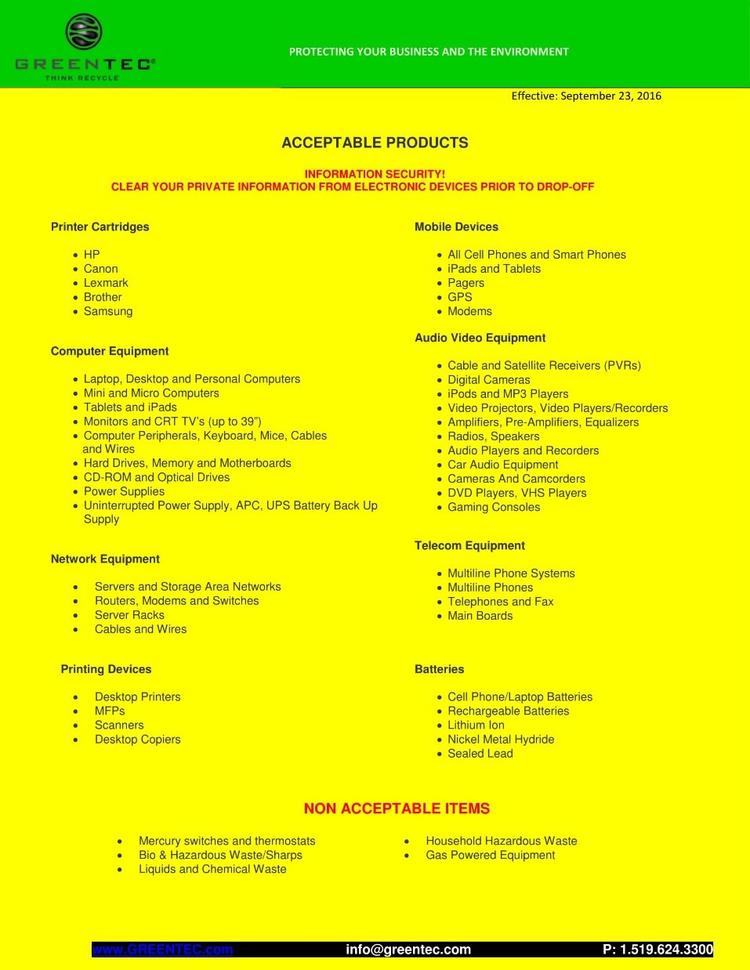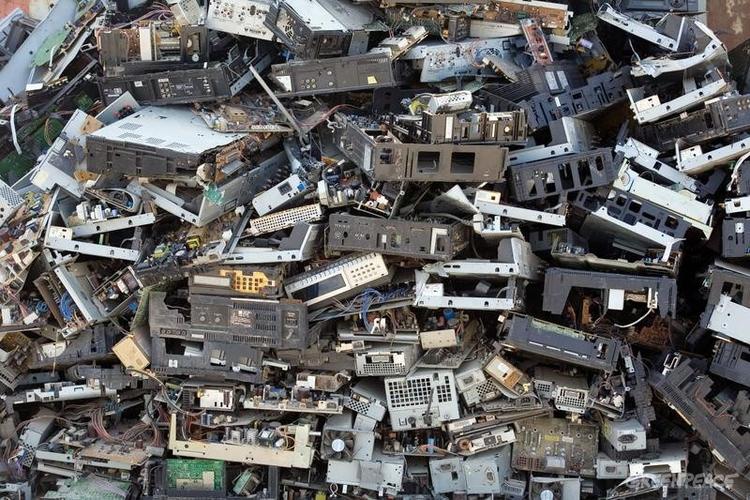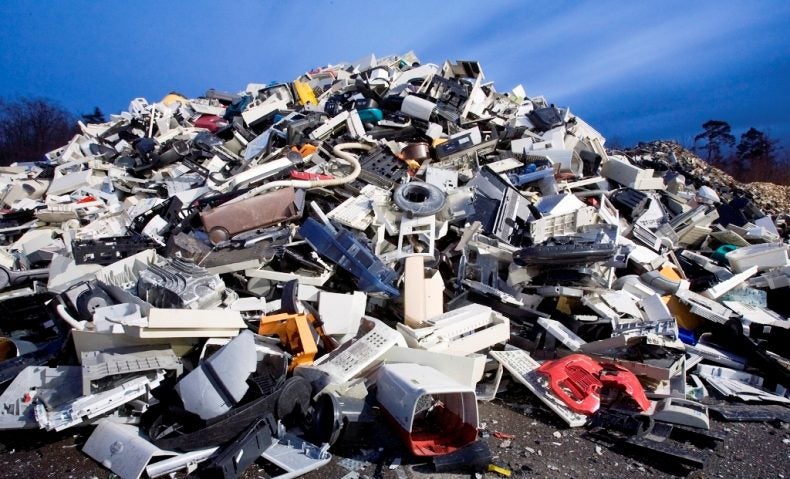What is E-waste?
Our beloved Mother Earth is facing increasing dangers to her health as environmental problems are mounting. If you could do something to help save your planet, wouldn’t you? One easy way you can help the environment is by disposing of your electronic waste (E-waste) safely. With technological advancements coming at an unprecedented rate, shrinking lifespans of consumer products, and society’s constant demand for the latest technologies, we are producing a giant amount of E-waste.
E-waste is any waste consisting of discarded electronic products. Greentec is the company that UWaterloo uses to safely recycle its E-waste. According to Greentec, E-waste recycling is the word used to describe the “disposal of all electronics in a safe, secure and regulated way that helps keep these devices from piling up in landfills or being shipped to foreign countries” [1].
The University of Waterloo accepts a wide range of electronic waste, including monitors, processors, printers, TVs, and audio-visual equipment. The university does not however accept any hazardous or chemical waste through the E-waste program. This is a full list of what Greentec and the university do and do not accept:

Greentec
Greentec was founded in 1995 and is located in Cambridge, Ontario. At the time of its founding, the company had four employees, but has now grown immensely and has around 70 employees [3]. Greentec prides itself in being completely transparent about its compliancy with government regulations and it is licensed by Ontario Minister of the Environment. According to Tony Perrotta, CEO of Greentec, “nothing goes to the landfill”. Products that can’t be refurbished are dismantled, separated and then sold for their parts (e.g. metals and plastics)[4].
E-waste at the University of Waterloo
At the University of Waterloo, Central Stores has an E-waste program in place so that electronics do not go into landfills. Any university staff, students, or faculty are encouraged to drop off their E-waste at East Campus Hall (ECH) from Monday to Friday between 7:30am and 4:30pm. This drop-off is also open to the general public, so any family or friends from the community are more than welcome to drop off their E-waste. Annually, this program diverts over 30 tons of e-waste [2].
If you are interested in seeing the types and the quantities of e-waste that the university disposes of, you can read past E-waste reports published by Central Stores. Just a little reminder: before disposing of your E-waste at Central Stores always make sure that you have completely wiped data from your device.

E-waste in Canada
45 % of E-waste in Canada is stored or reused, 11% is recycled, and the remaining 44% is sent to landfills. The majority of E-waste is household electronics, which make up about 30% of E-waste. Consumer electronics makes up around 15% of Canadian e-waste and 125 million kg of E-waste ends up in Canadian landfills a year. This amounts to around 4.5 kg per person. [1]

E-waste on a Global Scale
41.8 billion kilograms of E-waste was generated around the globe in 2014. Sadly, only 12.5% of this E-waste is currently recycled [5]. This number is far too low; as a society, we must work together to reduce the amount of E-waste that gets sent to the landfills. Currently, in the UK, for example, only 5% of companies opt to recycle their electronics, with the rest sending it to the landfills [6].
“Designed for the Dump”
E-waste is the fastest growing part of the waste stream [7]. This is largely because electronics are “designed for the dump”. What this means, is that products do not last long and are cheaper to replace than to fix. Companies should instead be making electronics more durable and modular so that they are easier to upgrade [8]. This would also allow parts of the product to be repaired as needed.
Nevertheless, 24% of laptops will fail in the first three years due to hardware malfunctions and the average life of a cell phone in the U.S. is around 18 months [9]. Another problem is that a lot of resources are being used to make these electronics. It takes 530 pounds of fossil fuel, 48 pounds of chemicals, and more than 3000 pounds of water to make just one computer and monitor [10].
Consequences of E-waste
The largest consequence of E-waste not being recycled properly is the amount of pollution it causes. In fact, even though E-waste represents a mere 2% of America's trash in landfills, it equals 70% of the overall toxic waste. The toxins that leech out from E-waste contaminate our air, water and communities. Lead and mercury are two of the largest toxins released from E-waste and they both have adverse health effects, particularly on children and developing fetuses [11].
Another consequence is the amount of valuable resources that are wasted. Cell phones and other electronic items contain high amounts of precious metals like gold or silver. Americans dump phones containing over $60 million in gold/silver every year. For every million cell phones that are recycled, 35,274 pounds of copper, 772 pounds of silver, 75 pounds of gold, and 33 pounds of palladium can be recovered.10 In addition, recycling E-waste saves a lot of energy. For every million laptops that are recycled instead of being sent to the dump, the energy equivalent of electricity used by 3,657 U.S. homes in a year is saved. [10]
What You Can Do
Try to see if your electronics can be upgraded so that you can continue using it instead of getting rid of them. If this is not possible, you can try to re-sell or donate them. If neither of these options work, be sure to recycle your electronics with a government approved company or here at the university!
References
[1] Greentec Discusses E-waste Recycling. (2016, December 9). Retrieved June 24, 2017, from https://www.therecycler.com/posts/greentec-discusses-e-waste-recycling
[2] University of Waterloo. Waste. (2017, January 10). Retrieved June 19, 2017, from https://uwaterloo.ca/sustainability/projects-and-initiatives/waste
[3] Greentec. (n.d.). About Greentec Company - Greentec. Retrieved June 12, 2017, from https://www.greentec.com/about-greentec/
[4] Howitt, C. (2010, December 08). Greentec Expanding Electronics Recycling Operations. Retrieved June 16, 2017, from https://www.therecord.com/news-story/2566629-greentec-expanding-electronics-recycling-operations/
[5] Mortillaro, N. (2015, September 14). Electronic waste is piling up. Here’s why you should care. Retrieved June 14, 2017, from http://globalnews.ca/news/2194391/electronic-waste-is-piling-up-heres-why-you-should-care/
[6] 95 percent of UK companies do not recycle computer equipment. (2013, July 10). Retrieved June 18, 2017, from https://www.therecycler.com/posts/95-percent-of-uk-companies-do-not-recycle-computer-equipment/
[7] Electronics TakeBack Coalition. Quickly Obsolete. (n.d.). Retrieved June 7, 2017, from http://www.electronicstakeback.com/designed-for-the-dump/quickly-obsolete/
[8] Leonard, A., Sachs, J., & Fox, L. (2010, November 04). The Story of Electronics. Retrieved June 22, 2017, from https://www.youtube.com/watch?v=sW_7i6T_H78
[9] Leonard, A. (2010, November 09). The Story of Electronics: Make 'Em Safe, Make 'Em Last, Take 'Em Back. Retrieved June 23, 2017, from http://www.huffingtonpost.com/annie-leonard/the-story-of-electronics_b_780978.html
[10] Electronics TakeBack Coalition, A Project of the Tides Center. (2014, June 25) Facts and Figures on E-Waste and Recycling. Retrieved June 17, 2017, from http://www.electronicstakeback.com/wp-content/uploads/Facts_and_Figures_on_EWaste_and_Recycling.pdf
[11] Environmental Protection Agency. Protect Your Family from Exposures to Lead. (2017, May 23). Retrieved June 13, 2017, from https://www.epa.gov/lead/protect-your-family-exposures-lead#products
[12] [Electronic Waste]. (n.d.). Retrieved from http://dalymovers.com/data/uploads/erecycling-logo.jpg










